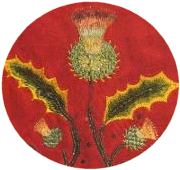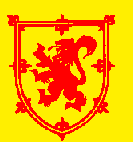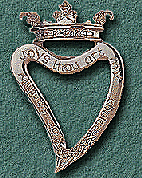The Scots have some well-known symbols as well as some mythic stereotypes. The Symbols, first: - The Thistle
- The Irish have the Shamrock and the Scots the Thistle. Many make reference to the spiny, tough character of the plant as an analogy of a Scots personality. The story of its adoption as a motif for the Scots is like this: During the reign of King Alexander III (1241-1285) of Scotland, King Haakon of Norway attempted to conquer
Scotland. According to the legend, the Norsemen tried a sneak attack at night on the Scottish camp at Largs. The
Norsemen were barefoot and they stepped on thistles. As they cried out in pain, the Scots were alerted and the
attack was rebuffed. The Norwegian king withdrew his army and the thistle became the Scottish national symbol.
- The Lion Rampant
- There is a second flag which is associated with Scotland, the "Rampant Lion", or Royal Flag of Scotland. It is
based on an older Scottish flag than the St. Andrew's Cross, and is widely used as a second national flag.
 The Rampant Lion flag flies over the offices of the Secretary of State for Scotland (who is the representative of the
U.K. government in Scotland); that is Dover House in London and New St Andrew's House in Edinburgh.
King George V signed a Royal Warrant in 1934 allowing the use of the Rampant Lion flag as "a mark of loyalty"
because of the forthcoming Jubilee celebrations. The Lord Lyon officially now takes the view that this permission
"related to decorative ebullition", that is, it is permissable to wave the flag at football matches. It is however not
allowable to fly the flag without permission, on a flag-pole or from a building. The Lord Lyon once threatened the
town councillors of Cumbernauld with an Act passed in 1679 which prescribed the death penalty for mis-use of the
royal arms.
The Rampant Lion flag flies over the offices of the Secretary of State for Scotland (who is the representative of the
U.K. government in Scotland); that is Dover House in London and New St Andrew's House in Edinburgh.
King George V signed a Royal Warrant in 1934 allowing the use of the Rampant Lion flag as "a mark of loyalty"
because of the forthcoming Jubilee celebrations. The Lord Lyon officially now takes the view that this permission
"related to decorative ebullition", that is, it is permissable to wave the flag at football matches. It is however not
allowable to fly the flag without permission, on a flag-pole or from a building. The Lord Lyon once threatened the
town councillors of Cumbernauld with an Act passed in 1679 which prescribed the death penalty for mis-use of the
royal arms.
Scotland has not had its own monarchy since the Act of Union with England in 1707. - The Luckenbooth
 The Luckenbooth has figures very similar to the Claddagh, and a similar purpose of being a love token. The luckenbooth charm also
continues the traditional theme of heart and crown. The earliest records of heart shaped brooches in Scotland date back to 1503. In the 18th Century, these brooches
were often known as 'Luckenbooth' brooches because they were sold from locked booths in the jewellery quarter of
St. Giles, Edinburgh. The Luckenbooth has figures very similar to the Claddagh, and a similar purpose of being a love token. The luckenbooth charm also
continues the traditional theme of heart and crown. The earliest records of heart shaped brooches in Scotland date back to 1503. In the 18th Century, these brooches
were often known as 'Luckenbooth' brooches because they were sold from locked booths in the jewellery quarter of
St. Giles, Edinburgh.
The heart-shaped brooch
dates back to the Middle
Ages when shopkeepers of
Edinburgh were given a
token to prove that they
had purchased a 'locking
booth' at the market. It
became a tradition to give
this to a loved one when
trading had ended. In the
time of Mary Queen of
Scots the brooch appears
with a crown, the original
a gift to Lord Darnley.This luckenbooth brooch is typical of the
traditional love tokens exchanged in
Scotland.
|